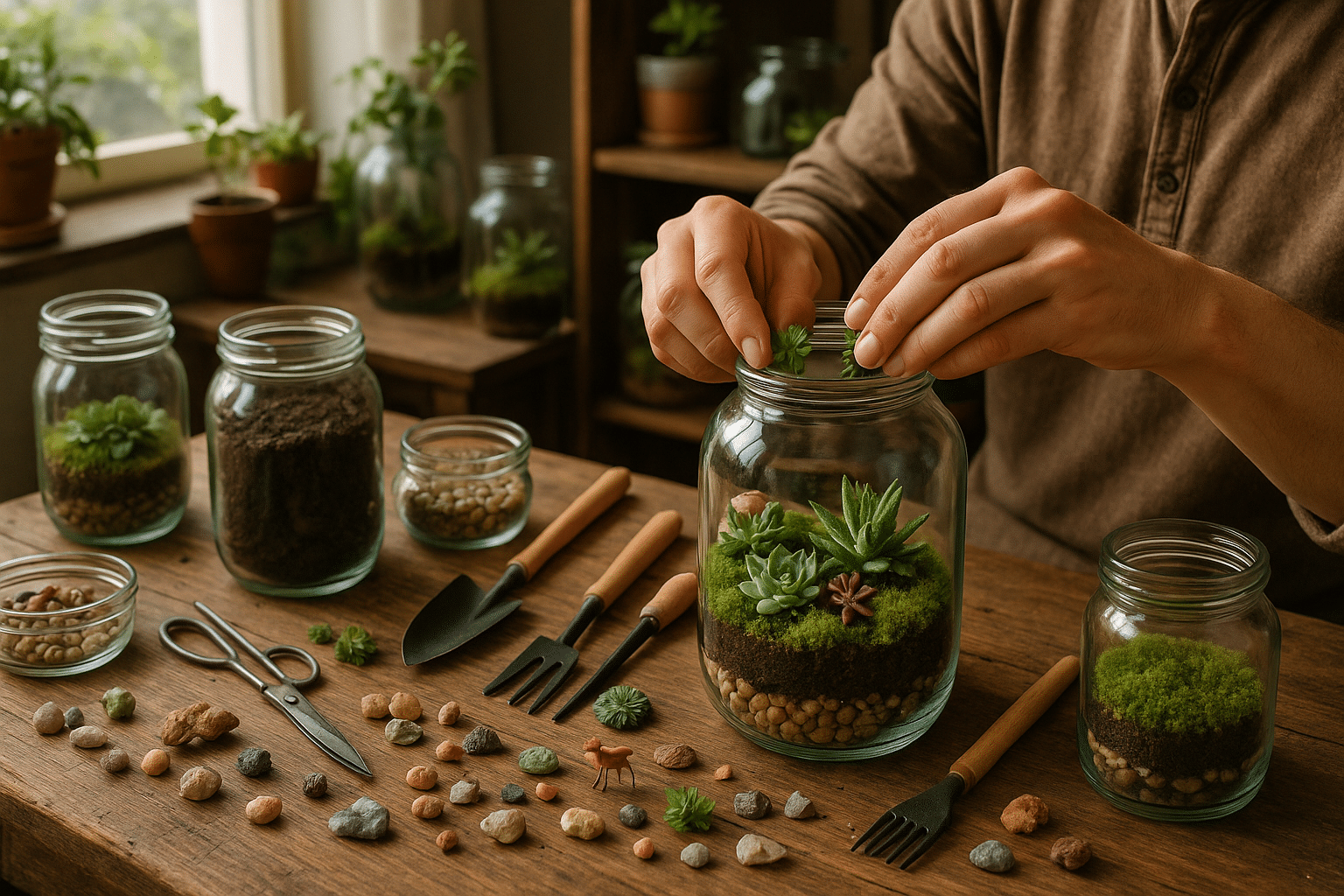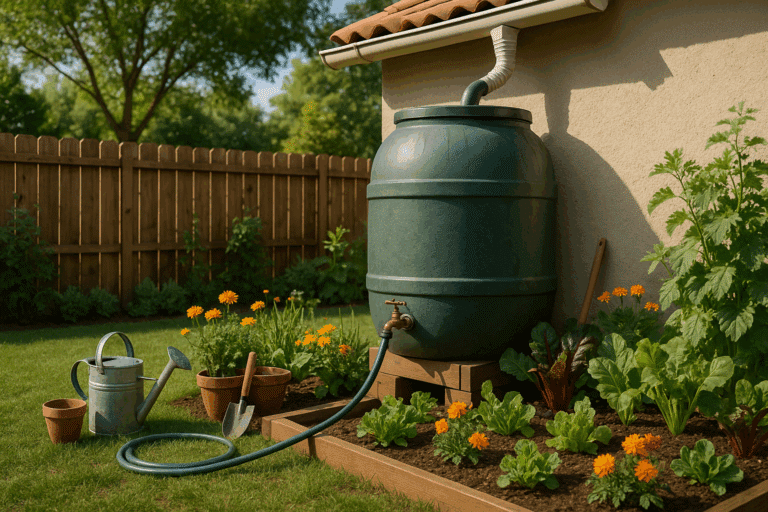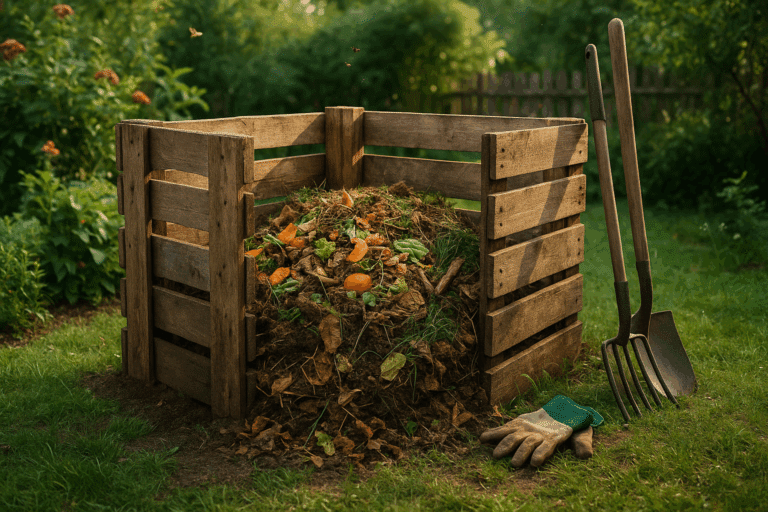In the confines of a glass container, you can cultivate a miniature garden, a small slice of nature in your own living room. 🌿 They are not only beautiful, but also serve as a reminder of our connection to the environment. But did you know that making your own terrarium can be both easy and environmentally friendly? In this comprehensive guide, we will explore the fascinating world of DIY terrariums, made with recycled glass.
What Is a Terrarium?
Before we delve into the nuts and bolts of creating your own terrarium, it’s important to understand what exactly a terrarium is. A terrarium is essentially a miniature, self-sustaining ecosystem, usually housed in a transparent container that allows light to enter. The container can be of any size or shape, from a small jar to a large aquarium. The plants and soil inside the terrarium create a microclimate, mimicking the natural habitat of the plants.
Why Use Recycled Glass?
Using recycled glass to create your terrarium is not only cost-effective but also eco-friendly. Every glass bottle or jar that you reuse reduces the amount of waste going into landfills. Plus, recycled glass containers can add a unique, vintage charm to your terrarium. 🌎
Benefits of Having a Terrarium
Terrariums are not just visually appealing; they also have various benefits. They are a great way to bring a bit of nature indoors, especially in urban settings where green space may be limited. Terrariums can also help improve indoor air quality by producing oxygen and removing toxins from the air. Additionally, the act of creating and maintaining a terrarium can be a relaxing and therapeutic hobby.
Over the course of this article, we will walk you through the process of creating your own stunning DIY terrarium using recycled glass. We will cover everything from selecting the right container and plants to the correct way to layer your terrarium for optimal plant health. You will also get practical tips and tricks to ensure your terrarium thrives, creating a lush, miniature ecosystem in your home.🌱
We will also delve into more advanced terrarium concepts, such as creating different types of terrariums (desert, tropical, aquatic) and using terrariums as a teaching tool to understand larger ecological concepts. Whether you’re a seasoned green thumb or a budding plant enthusiast, there’s something for everyone in this guide.
So grab that old mason jar, roll up your sleeves, and get ready to create your very own pocket-sized paradise. Let’s green up your space together! 🌳
🌿 Embrace the Green Revolution with DIY Glass Terrariums
As we face a global climate crisis, making sustainable choices is no longer optional—it’s imperative. But going green doesn’t always have to be about massive lifestyle overhauls. Sometimes, it’s the smaller acts of reusing, recycling, and re-purposing that make the most significant difference. One such eco-friendly project that marries creativity with sustainability is creating DIY terrariums using recycled glass.
Not only do these miniature greenhouses add a splash of nature to your living space, but they also provide an excellent way to recycle glass jars and containers that would otherwise end up in landfills. Intrigued? Read on to discover how you can transform ordinary glass jars into stunning DIY terrariums.
Before we delve into the step-by-step process, let’s understand what a terrarium is. A terrarium is a self-contained indoor garden, usually housed within a clear container for easy viewing of the vegetation inside. Terrariums work on the principle of creating a small, water-cycle controlled environment for plants. It’s nature in a jar—literally! Now, let’s begin our exciting DIY project.
🔎 Selecting the Perfect Glass Container
Any clear glass container could serve as a potential home for your terrarium. But to create a truly stunning terrarium, you’ll need to choose your container wisely. A clear, large glass jar with a lid works best as it provides ample space for your plants and creates a visually appealing mini-ecosystem. Old mason jars, pasta sauce jars, and even glass teapots can be transformed into terrariums.
Remember, the shape and size of your container will dictate what type of plants you can grow and how many you can accommodate. Also, if you choose a container with a lid, you’ll create a closed terrarium, which is self-sustaining and requires minimal care. On the other hand, an open terrarium needs frequent watering but offers more versatility in plant choices.
Check out this detailed video from “Succulents and Sunshine” titled “How to Make a Terrarium in a Jar” to learn more about choosing your terrarium container.
🌱 Choosing the Right Plants
Once you’ve selected your glass container, it’s time to choose your plants. Selecting the right plants is crucial for your terrarium’s health and aesthetic appeal. The best plants for terrariums are small, slow-growing, and enjoy high humidity. Some excellent choices include Ferns, Mosses, African Violets, and Air Plants.
It’s also essential to choose plants with similar light and water requirements. Mixing a cactus (which needs lots of light and little water) with a fern (which prefers shade and constant moisture) might lead to an unhappy terrarium.
Use the table below to match your chosen plants’ light and water requirements and ensure a thriving terrarium:
| Plant Type | Light Requirement | Water Requirement |
| Ferns | Low to medium indirect light | High |
| Mosses | Low to medium indirect light | High |
| African Violets | Medium to high indirect light | Medium |
| Air Plants | Medium to high indirect light | Low |
🛠️ Constructing Your DIY Terrarium
With your glass container and plants ready, it’s time to get your hands dirty! But before you start, you’ll need some additional materials: pebbles or small rocks, activated charcoal, potting soil, and any decorative items you’d like to add, like miniature figurines or crystals.
Start by layering pebbles at the bottom of your container. This layer aids in drainage and prevents your terrarium from becoming a swamp. Next, add a thin layer of activated charcoal. The charcoal keeps the terrarium’s environment fresh by filtering the air and preventing mold and bacterial growth.
On top of the charcoal, add a layer of potting soil. This will be the bed for your plants. Now you’re ready to plant! Make small holes in the soil for your plants, and gently nestle them in. Finally, add any decorative items you’d like.
Check out this engaging video tutorial from “BuzzFeed Nifty” titled “How to Make a Terrarium” for a visual guide on constructing your DIY terrarium.
🌞 Maintaining Your Terrarium: Light, Water, and Love
Now that your DIY terrarium is complete, it’s time to ensure it thrives. Proper light and water are key. Most terrarium plants need indirect light—direct sunlight might cause your terrarium to overheat. A spot near a north or east-facing window is usually perfect. If natural light is scarce, a fluorescent or LED light can substitute.
Watering your terrarium can be a bit trickier. Closed terrariums rarely need watering as they create their own water cycle. Open terrariums, however, will need regular watering, but be careful not to overwater. Overwatering can lead to root rot, a common killer of terrarium plants.
Finally, remember to show your terrarium some love. Prune overgrown plants, remove dead leaves, and keep the glass clean for optimal viewing. With some care and attention, your DIY glass terrarium will flourish, adding a touch of green to your space and reducing your carbon footprint, one recycled jar at a time.

Conclusion
In conclusion, the journey we embarked on in this article has been an exploration of key concepts in the realms of IT and engineering. The aim was not just to impart knowledge, but also to stimulate the intellectual curiosity of our esteemed readers. This exploration was not intended to be exhaustive, but to provide a comprehensive overview of the subject, with the hope that it will inspire further study and application.
We have navigated through the intricacies of software development and demystified complex concepts in IT, shedding light on the importance of these fields in today’s digital world. The knowledge we’ve gained in this read is not just a collection of theoretical concepts, but a practical toolset that can be utilized to solve real-world problems.
We dived into the concept of Agile methodologies and their significance in software development. We unraveled how these methodologies, when properly applied, can enhance productivity, improve quality, and expedite the delivery of software products. 💡
We also peered into the realm of cyber-security, understanding the necessity of securing our digital spaces in the rapidly evolving tech landscape. The perils of data breaches and cyber-attacks are very real, making cybersecurity a mandatory aspect in all areas of IT. 🛡️
Moreover, we explored the fascinating world of artificial intelligence (AI), understanding its potential in transforming industries, economies, and societies at large. AI, with its numerous applications, is poised to be a game-changer, making its understanding paramount for every tech enthusiast. 🚀
Each of these topics is not just a standalone subject, but interconnected pieces of a larger jigsaw puzzle. Understanding each piece and its relation to others creates a holistic view of the digital world we live in.
Remember, technology is a tool, and the more proficient we are in wielding it, the more problems we can solve, and the more value we can add to our lives and society.
We hope this article has been enlightening and engaging. Please feel free to comment, share, and apply what you have learned. 📚
Keep exploring, keep learning! 🌐
For further reading and research, consider visiting the following active links:
1. [Agile Methodologies](https://www.agilealliance.org/agile101/)
2. [Cybersecurity](https://www.csoonline.com/article/2130877/what-is-cyber-security-definition-best-practices-technologies.html)
3. [Artificial Intelligence](https://www.ibm.com/cloud/learn/what-is-artificial-intelligence)
Happy reading!
References:
1. [Software Engineering](https://www.sciencedirect.com/science/article/pii/S1877050916302465)
2. [IT Industry](https://www.britannica.com/technology/IT-industry)
This article was written by Rodrigo Almeida, a Software Engineer and technical writer with over a decade of experience in IT and Engineering. Feel free to reach out for any queries or feedback. 🖊️
Remember to keep pushing the boundaries of knowledge. After all, in the words of the great Isaac Newton, “What we know is a drop, what we don’t know is an ocean.” 🌊



